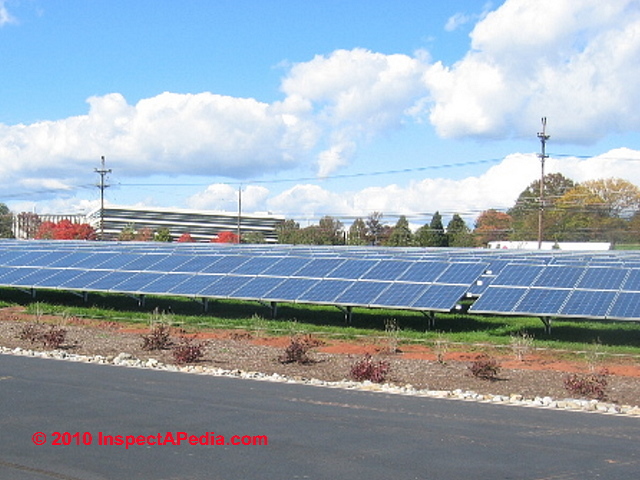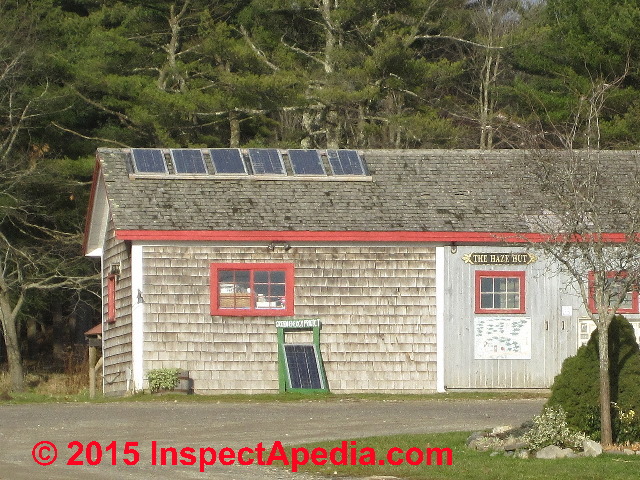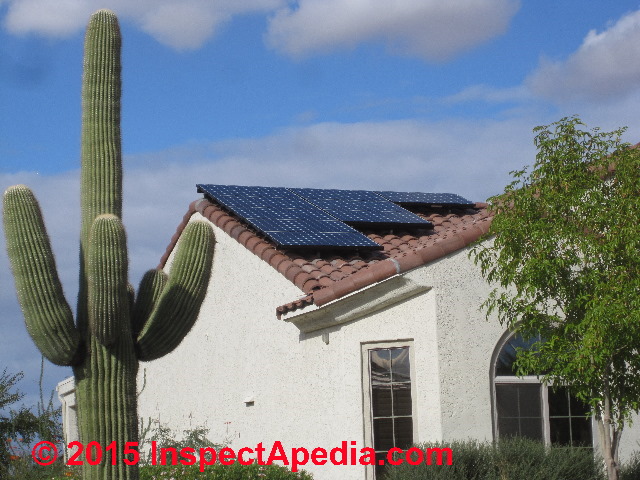 Renewable Energy: Photo-Voltaic PV Module Electrical Power Shopping Guide - Solar & Renewable Energy Systems
Renewable Energy: Photo-Voltaic PV Module Electrical Power Shopping Guide - Solar & Renewable Energy Systems
- POST a QUESTION or COMMENT about buying, installing & troubleshooting photovoltaic systems on solar powered homes
Photovoltaic panel choices:
This article explains photovoltaic electrical power supply products used in solar energy systems.
Here we include solar energy, solar heating, solar hot water, and related building energy efficiency improvement articles including material reprinted/adapted/excerpted with permission from Solar Age Magazine - editor Steven Bliss.
Our page top photograph shows a portion of an extensive photovoltaic solar panel array installed by Ortho McNeil Pharmaceutical, Inc. (Johnson & Johnson), and located on Rte. 202 in Raritan, New Jersey. The system was completed in 2007. Photo courtesy of Paul Galow.
InspectAPedia tolerates no conflicts of interest. We have no relationship with advertisers, products, or services discussed at this website.
- Daniel Friedman, Publisher/Editor/Author - See WHO ARE WE?
Shopping Advice for Photovoltaic Power Supplies for Solar Systems
[Click to enlarge any image]
Our photo above shows photovoltaic panels installed on utility poles in Haddonfield, NJ, a community where extensive use of solar energy is supported. Below are photos of photovoltaic panel installations in Phoenix, Arizona and in Portland Maine, demonstrating the broad geographic appeal of these systems. The cactus (below right) will give a clue about which of the buildings is found in Arizona.
As of January 2010, China dominates the production of both solar and wind renewable energy equipment, generators, and controls.
The New York Times reports that most of the wind turbines and wind energy being installed in the U.S. as well as most of the solar panels being used in the U.S. are being produced in China, and that G.E. (General Electric) makes nearly half the wind turbines used in the United States.
U.S. President Obama has called for American Industry to step up its production of renewable energy equipment. Vestas, a Danish corporation, has completed the world's biggest wind turbine manufacturing facility, located in northeastern China, effectively transferring the latest turbine technology for wind turbine generators and turbine controls to that country.
China intends to produce 8 percent of its electricity generation by renewable energy by 2020, compared with the current 4% level in both China and the U.S. In China, wind energy remains 20-40% less costly than that produced from coal. But renewable energy costs continue to fall.
Historical & Current Prices for Photovoltaic Solar Panels
The question-and-answer article below paraphrases, quotes-from, updates, and comments an original article from Solar Age Magazine and written by Steven Bliss.
How Much Photovoltaic Power do I Need and How Much Should I Spend on Photovoltaic Power Supply
Question: How Much Photovoltaic Power Can I Buy for $11,000.?
I am building a 3000 square foot passive solar house in Aspen, CO, 1500 feet away from the local power company line. They want $11,000. (1985 prices) for an underground line to the house.
How much photovoltaic power can I get for that much money? My minimum power consumption is around 500 kWh/month. Maximum electrical energy consumption would be about 1000 kWh/Month. I have a good solar site and a 5-kW backup electrical generator. -- Tim Howe, Old Snowmass, CO.
Answer #2: Solar Energy Technology and Costs - Price per Watt (Current)
Our photo of rooftop mounted photovoltaic panels (left) shows an installation in Festival, AZ, outside Phoenix.
Three Photovoltaic Technologies: Thin Film, Conventional, & High Efficiency: efficiency levels and relative costs:
According to Leyden, by 2009 the cost of photovoltaic systems had fallen to one tenth of photovoltaic module prices (in dollars per Watt or $/Wp) in 1976, from about $42. per Wp in 1976 to $4.50 / Wp in 2009. (Source: Navigant Consulting).
More recent price estimates (Solarbuzz) trace the price per watt Wp from $5.40 Wp at the end of 2001 down to $3.60 USD per watt Wp by November 2010 in the U.S., and down to $3.20 EU per watt Wp in European Euros. The lowest prices we found (Solarbuzz) was $1.37 Wp for a 60-watt thin film solar module.
Experts indicate that the price of producing electricity from solar sources will probably cross over and then be less than the costs of electricity production by the conventional grid by about 2017.
Current Photovoltaic Efficiency levels depends on the type of collector installed:
- Thin film Photovoltaics operate at roughly 9.5% Efficiency. (Typically also sold at a lower cost per watt than multicrystalline silicon solar modules or monocrystalline silicone modules).
- Conventional Photovoltaic Solar Collectors operate at roughly 12.6% Efficiency
- High Efficiency Photovoltaic Solar Collectors operate at roughly 19.3% Efficiency.
- Leyden, 2009.
Components of Price of Photovoltaic Solar Energy Systems
- Solar Module Cost - quoted in price per watt or Wp as we described just above.
- Solar Photovoltaic Inverter Cost - $0.72 USD per continuous watt (November 2010) (Solarbuzz)
- Solar Photovoltaic System Battery Cost - $0.21 USD per output Watt Hour (November 2010) (Solarbuzz), note that not all installations make use of a battery
- Solar Photovoltaic System Charge Controller Cost - $5.87 USD per Amp (November 2010) (Solarbuzz)
A Comparison of Solar-Based Electricity to Conventional Electricity Costs per Kilowatt Hour
For a non-expert it can be difficult to make sense of these various solar photovoltaic system component costs - they are not simply additive since they are not all expressed as cost per watt. Solarbuzz reported (November 2010) that the residential electricity produced using solar modules cost about $0.32 USD per kilowatt hour, and that commercial and industrial electrical costs were $0.22 and $0.17 USD per KWH.
The U.S. Energy Information Administration (EIA) publishes average retail prices of electricity by end use sector and by U.S. State. Quoting from the EIA's August 2010 data for average retail price for electricity for residential customers, the cost per kilowatt hour ranged from $0.08 (Washington State) to $0.29. (Hawaii).
The average electricity cost across the entire U.S. (August 2010) was $0.12 per KWH: in other words, in the fall of 2010, electricity generated by photovoltaic systems cost roughly 2.6 times the U.S. overall average price per KWH.
For areas where electrical energy cost is sufficiently above the U.S. average, solar-based systems can show a rapid payback.
Historical Solar Energy Costs: Solar Energy Costs in the Mid 1980's
Our photo of photovoltaic solar panels atop an outhouse is from the Poughkeepsie NY Railroad Bridge rail trail crossing the Hudson River. This three-panel photovoltaic installation is sufficient to power interior lighting and a ventilating fan in this public toilet facility.
According to Solar Age technical editor Joe Kohler, of KLR Engineering, you should be able to buy an 840-peak watt photovoltaic power supply system, with an inverter, charge controls, meters, racks, installation, and 1200 amp-hours of battery storage for your $11,000. (at 1980's prices for photovoltaics).
You could expect to get about 200 kWh from this system in the best summer month, and close to 100 kWh in the dead of winter.
With a very efficient refrigerator, florescent lights, and a gas-powered water heater and stove, you should be able to live quite well.
- For another $4000. you could buy half again as much photovoltaic power. (Again, these are 1980's prices).
With moderate conservation and a 1260-watt photovoltaic electrical system, no one will know that you are not on the grid. - Remember that you can expect to get state and federal tax credits of up to $7000. when you buy the system, so you could spend up to $18,000. for photovoltaic power (PV power) and still have a net cost about equal to what the electrical power company wants to charge to connect your building to the power grid.
You would need to have large tax liabilities to take all the tax credits at once.
Also keep in mind that photovoltaic electrical power systems are modular and expandable. You could add photovoltaic solar panels as your budget permits and, at least until the end of 1985 in Colorado, photovoltaic electrical system installers could take tax credits again for add-on purchases.
Check with your state and federal tax authorities on current tax credits available for photovoltaic electrical systems as well as other passive solar design components.
Manufacturers of Photovoltaic PV Solar Modules
As of November 2010 we found an extensive list of manufacturers and websites for solar modules. Some of these manufacturers also produce solar cells. Countries represented among this list of solar module manufacturers include Australia, Brazil, Canada, France, Greece, Japan, Korea, Mexico, South Africa, Switzerland, United Kingdom (UK), United States (USA). Generally all of these companies distribute their products world-wide.
Our detailed list of solar module manufacturers is now found at SOLAR MODULE MANUFACTURERS.
Original article:
The link to the original Q&A photovoltaic solar panel article in PDF form immediately below is preceded by an expanded/updated online version of this article.
- Photovoltaic Shopping List Q&A on - PDF version, Use your browser's back button to return to this page\
...
Continue reading at REMOTE ELECTRIC POWER, PHOTOVOLTAIC or select a topic from the closely-related articles below, or see the complete ARTICLE INDEX.
Or see these
Recommended Articles
- SOLAR ENERGY SYSTEMS - home
Suggested citation for this web page
PHOTOVOLTAIC POWER SYSTEMS at InspectApedia.com - online encyclopedia of building & environmental inspection, testing, diagnosis, repair, & problem prevention advice.
Or see this
INDEX to RELATED ARTICLES: ARTICLE INDEX to BUILDING ENERGY SAVINGS
Or use the SEARCH BOX found below to Ask a Question or Search InspectApedia
Ask a Question or Search InspectApedia
Try the search box just below, or if you prefer, post a question or comment in the Comments box below and we will respond promptly.
Search the InspectApedia website
Note: appearance of your Comment below may be delayed: if your comment contains an image, photograph, web link, or text that looks to the software as if it might be a web link, your posting will appear after it has been approved by a moderator. Apologies for the delay.
Only one image can be added per comment but you can post as many comments, and therefore images, as you like.
You will not receive a notification when a response to your question has been posted.
Please bookmark this page to make it easy for you to check back for our response.
IF above you see "Comment Form is loading comments..." then COMMENT BOX - countable.ca / bawkbox.com IS NOT WORKING.
In any case you are welcome to send an email directly to us at InspectApedia.com at editor@inspectApedia.com
We'll reply to you directly. Please help us help you by noting, in your email, the URL of the InspectApedia page where you wanted to comment.
Citations & References
In addition to any citations in the article above, a full list is available on request.
- Solar Age Magazine was the official publication of the American Solar Energy Society. The contemporary solar energy magazine associated with the Society is Solar Today. "Established in 1954, the nonprofit American Solar Energy Society (ASES) is the nation's leading association of solar professionals & advocates. Our mission is to inspire an era of energy innovation and speed the transition to a sustainable energy economy. We advance education, research and policy. Leading for more than 50 years. ASES leads national efforts to increase the use of solar energy, energy efficiency and other sustainable technologies in the U.S. We publish the award-winning SOLAR TODAY magazine, organize and present the ASES National Solar Conference and lead the ASES National Solar Tour – the largest grassroots solar event in the world."
- Steve Bliss's Building Advisor at buildingadvisor.com helps homeowners & contractors plan & complete successful building & remodeling projects: buying land, site work, building design, cost estimating, materials & components, & project management through complete construction. Email: info@buildingadvisor.com
Steven Bliss served as editorial director and co-publisher of The Journal of Light Construction for 16 years and previously as building technology editor for Progressive Builder and Solar Age magazines. He worked in the building trades as a carpenter and design/build contractor for more than ten years and holds a masters degree from the Harvard Graduate School of Education. Excerpts from his recent book, Best Practices Guide to Residential Construction, Wiley (November 18, 2005) ISBN-10: 0471648361, ISBN-13: 978-0471648369, appear throughout this website, with permission and courtesy of Wiley & Sons. Best Practices Guide is available from the publisher, J. Wiley & Sons, and also at Amazon.com - Paul Galow [Website galowconsulting.com ] - technical consultant on networking, LAN design, applications support. Galow Consulting Services [Website galowconsulting.com ] , 914-204-1749, email: paulgalow@galowconsulting.com
- Thomas Leyden, Managing Directory, "Solar Renewable Energy - Now", ISPE Meeting, 20 October 2009, retrieved 11/30/2010, original source: http://www.ispe.org, International Society for Pharmaceutical Engineering, 3109 W. Dr. Martin Luther King, Jr. Blvd., Suite 250, Tampa, Florida 33607-6240 USA Tel: +1-813-960-2105, Email: ASK@ispe.org. The presenter, Thomas Leyden, is Managing Director, SunPower Corporation, Systems. He can be reached at 609-964-8901 or Email: tleyden@sunpowercorp.com - Quoting ISPE:
- In addition to citations & references found in this article, see the research citations given at the end of the related articles found at our suggested
CONTINUE READING or RECOMMENDED ARTICLES.
- Carson, Dunlop & Associates Ltd., 120 Carlton Street Suite 407, Toronto ON M5A 4K2. Tel: (416) 964-9415 1-800-268-7070 Email: info@carsondunlop.com. Alan Carson is a past president of ASHI, the American Society of Home Inspectors.
Thanks to Alan Carson and Bob Dunlop, for permission for InspectAPedia to use text excerpts from The HOME REFERENCE BOOK - the Encyclopedia of Homes and to use illustrations from The ILLUSTRATED HOME .
Carson Dunlop Associates provides extensive home inspection education and report writing material. In gratitude we provide links to tsome Carson Dunlop Associates products and services.






